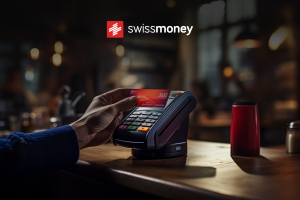Accepting card payments is critical for businesses, that want to increase sales and ensure a greater customer experience. It stays relevant whether you run a physical store, an e-commerce platform, or provide on-the-go services.
If you want to find out the basics of debit and credit card payments, including the many options accessible to businesses today, keep reading.

How to accept card payments?
Whether you’re accepting debit or credit card payments in person or online, the following steps are fundamental:
- Customer inputs their payment information into the payment processor by swiping, inserting, tapping, or entering their credit or debit card numbers.
- The payment processor checks the cardholder’s available balance or credit limit with the card issuer and looks for signs of fraud.
- The customer’s bank account is debited, and the sum is deposited into your merchant account if the bank confirms the transaction.
Methods of accepting credit card payments
There are many various ways of accepting credit card payments. Here are the main ones:
Card machines
Card machines streamline the payment process for customers at traditional brick-and-mortar companies. This no-frills approach has been critical in bringing about the unprecedented ease with which we now buy.
Notably, many card readers have evolved to embrace contactless payment technology. It allows customers to complete transactions swiftly and hygienically by merely tapping their cards or mobile devices on the reader.
In terms of getting a card machine, some providers offer an option to purchase it outright and pay a fixed fee per transaction. This approach ensures that you own your hardware and don’t have additional costs when it’s not in use.
Payment gateways
Payment gateways are essential components of e-commerce websites. They serve as interfaces for customers to input their payment information, facilitating debit or credit card transactions.
This technology is not limited to physical card-reading devices in stores. It also encompasses online payment processing portals. Therefore, it is crucial to verify the compatibility of your e-commerce site with the specific payment gateways you intend to use.
E-commerce platforms
Card payments online enable customers to make card payments via the Internet when purchasing goods. Various online payment methods are available, including credit or debit cards, wire transfers, net banking, and digital wallets.
To accept payments online for e-commerce or other business purposes, you’ll need an account with a payment service provider (PSP) such as PayPal, Stripe, Square, Apple Pay, or Shopify.
Integrating online payments with your online storefront is typically straightforward, especially with the right website builder. Many modern website builders and marketplaces let you simplify online purchases and seamlessly connect with payment processors.
However, if your existing website does not integrate well with payment providers, you might need to create a link to your account, such as a PayPal payment gateway on your website.
It allows customers to make payments through the third-party site. This approach may be less seamless and could require additional manual effort on your part to manage orders effectively.
In-store card payments (POS)
In physical retail, in-store card payments offer diverse options, including cash, credit, and debit cards, EMV (chip cards), NFC-enabled digital wallets, and government-assisted options like EBT.
This flexibility is available through point-of-sale (POS) systems with card readers or standalone credit card terminals. Leading modern POS systems integrate hardware and software, enabling the processing of card and cash transactions.
Mobile payment apps
Mobile payment processing apps make it possible to accept plastic cards from customers without requiring any additional hardware beyond a smartphone. These portable options are fantastic for selling items at events like farmer’s markets, craft exhibits, trade shows, and parties.
You can always try to find free software on the Google Play Store and the Apple App Store. These apps allow you to process credit card payments on the go much like a traditional point-of-sale terminal. Customers can digitally sign their authorization of the transaction, if necessary.
Virtual terminal
A virtual terminal platform is a web-based service that allows businesses to take card payments, most commonly credit cards, even when the card is not physically present.
Customers can use it to pay over the phone by inputting their card number, expiration date, card security code (CSC), and the numeric part of their billing address postcode.
Merchant account
Merchant accounts are company bank accounts that allow companies to accept and manage payments made over the Internet. With this system, businesses accept several forms of electronic payment. Online firms that do online transactions must have a merchant account relationship.
The primary functional distinction between merchant accounts and business bank accounts is the former’s focus on credit card transactions and the latter’s – on all of a company’s money.
Types of card payments
Card payments encompass various types of transactions, each serving different purposes and payment scenarios. Here are the ten most common types of card payments:
Credit card payments
Credit card payments are a widely adopted method, where customers utilize credit cards issued by financial institutions to make purchases.
These payments have the flexibility to pay off their outstanding balance later, often in monthly installments, though interest may accrue if they choose not to pay the full amount.
Debit card payments
Debit card payments, on the other hand, are directly linked to a customer’s bank account. Payments are deducted in real-time from the account balance, typically without incurring interest charges. This method offers the convenience of cashless transactions while keeping spending in check.
📚Read more: The Future of Transactions: Exploring Cashless Payment Methods
Prepaid card payments
Prepaid card payments involve cards that are preloaded with a specific amount of money in advance. Customers can use these cards to make purchases until the balance is depleted. They help manage budgets and prevent overspending.
Contactless payments
Contactless payments represent a modern and swift approach to transactions. Customers can tap or wave their contactless cards or mobile devices, such as smartphones or smartwatches, near a compatible reader to complete a payment. It is a fact and convenient method, especially in retail.
Mobile wallet payments
Mobile wallet payments are gaining popularity as customers link their credit, debit, or prepaid cards to mobile wallet apps like Apple Pay, Google Pay, or Samsung Pay.
These apps allow them to make secure transactions using their smartphones or smartwatches, often with added layers of security like fingerprint or facial recognition.
📚Related: Who Accepts Google Pay? Places to Keep in Mind
📚Related: Samsung Pay vs Google Pay
EMV chip payments
EMV chip payments incorporate cards with embedded microchips that enhance security. Customers either insert the card into a chip reader or use it for contactless transactions, reducing the risk of fraud associated with traditional magnetic stripe cards.
Online payments
Online payments are the lifeblood of e-commerce. Customers enter their card details into secure payment forms on websites to make purchases. This method has become increasingly important in the digital economy, offering convenience and a wide range of shopping options.
Other payment methods
Also, many other payment methods are less popular:
Recurring card payments are commonly used for subscription services. Customers authorize recurring payments, and their cards are charged at predetermined intervals without the need for manual authorization. This ensures uninterrupted access to services.
In-app payments cater to the mobile era, allowing customers to make purchases within mobile apps and games. This is made easy by storing card information or integrating mobile wallets, streamlining transactions within the app’s ecosystem.
Virtual card payments provide enhanced security for online transactions, particularly for one-time or high-risk purchases. Temporary virtual cards are generated with limited validity and usage, minimizing the risk of fraud and unauthorized charges.
FAQ
How do I accept card payments in the UK?
You must set up the necessary infrastructure to accept card payments in the UK. Another choice to make is how you accept payments. There are three most popular ways to do so:
- At a physical location using a card machine
- Over the mobile phone
- Online using a payment gateway
Can I use my phone to accept card payments?
Yes, you can use your smartphone to accept card payments.
Many payment processors offer mobile card readers that you can attach to your phone. They allow you to accept chip and PIN, contactless, and swipe card payments.
Mobile wallet apps like Google Pay and Samsung Pay enable customers to make tap-to-pay methods by nearing their smartphones or smartwatches to their devices.
You can also leverage mobile payment apps, invoicing apps with “Pay Now” options, QR code payments, and online payment gateways integrated into your website or app. This flexibility makes it easy to adapt to various payment preferences and expand your business’s payment options.
Can I take credit card payments without a card machine?
Yes, you can accept card payments without a traditional card machine. In today’s technologically advanced era, there are numerous alternatives to facilitate card transactions.
Mobile card readers, mobile wallet apps, payment apps, QR code payments, and online payment gateways offer versatile options for businesses to receive card payments.
Moreover, mobile merchants, street vendors, and startup owners who need a lightweight alternative can benefit greatly from these payment processing options.
With these options, businesses can more easily accommodate their consumers’ varying payment preferences in brick-and-mortar and online stores.

